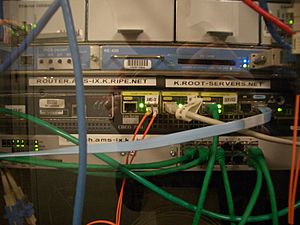Root server facts for kids
A root server is a very important computer server in the Domain Name System (DNS). Think of DNS as the internet's phone book. When you type a website address like www.google.com, your computer needs to find its special number, called an IP address. Root servers help your computer find the right place to ask for that number.
There are 13 main root servers in the world. They are named with letters from A to M. When your computer wants to visit a website, it first asks its ISP (Internet Service Provider) for the website's IP address. If the ISP doesn't know it right away, it will ask one of these root servers. The root server then tells your ISP which other DNS server knows the IP address for that specific website, like one ending in .com or .net.
How Root Servers Started
The idea for the Domain Name System (DNS) began in 1981. It was created to make it easier to find websites. Before DNS, you had to know the exact IP address (a string of numbers) for every website you wanted to visit. DNS changed that, letting us use easy-to-remember names like google.com.
In 1984, the first top-level domains (TLDs) were created. These are the last parts of website addresses, like .com, .org, or .net. In 1985, the very first domain name was registered, and that's when the modern DNS system, with root servers helping everything work, truly began.
See also
In Spanish: Servidor raíz para niños


